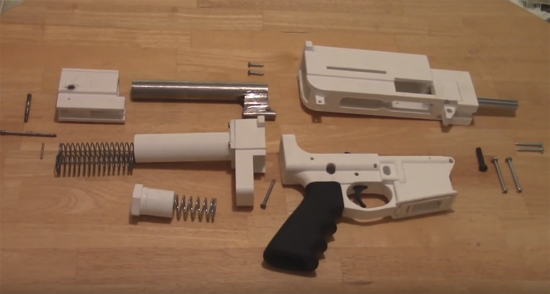
The next stage in the evolution of the 3D printed firearm. Courtesy of YouTube.
Latest News
August 20, 2015
It is a sign of the times when old disputes take on new form thanks to the Internet. The entertainment industry must look back on the old days of people copying movies and music onto tapes with nostalgia, compared to the massive amounts of online piracy. The debate over gun control has taken a similar path with the advent of 3D printed guns.
For awhile, the only real option online was the “Liberator,” developed by Cody Wilson. The gun was mainly made of plastic, with a few metal parts to assist with firing and, according to Wilson, make the gun detectable so it would be considered legal. The US State department disagreed with his assessment and told him to take the plans offline.
 The next stage in the evolution of the 3D printed firearm. Courtesy of YouTube.
The next stage in the evolution of the 3D printed firearm. Courtesy of YouTube.Regardless of its legality, the “Liberator” was a one-and-done type weapon. People have been making similar kinds of firearms at home for years without 3D printing. Without the durability of metal parts, the “Liberator” wasn’t really anything to be concerned about from a safety perspective.
Gun enthusiasts knew that as well and rather than be dissuaded from building 3D printed weapons, they have sought to find better ways to build a firearm. Without access to more expensive metal additive manufacturing (AM) systems, their options were somewhat limited. Rather than attempting to upgrade the “Liberator,” one enterprising, amateur gunsmith has developed plans for a hybrid weapon.
The “Shuty” is made of both metal and plastic parts. The plastic parts have been printed on an Orion system using standard PLA, and the metal parts are, by and large, available at your local hardware store. By combining both metal and plastic, the Shuty is more durable than the “Liberator” and is capable of firing multiple shots before it begins to degrade.
Even with the upgrades, the Shuty isn’t what you’d call a phenomenal piece of weapons technology. It works (it even has a crude safety), but it really seems like a lot of effort to produce something that is inferior in every way to the least expensive pistol you could buy at a gun show. What it does show is that people are willing and able to move ahead with the design and fabrication of 3D printed weapons, regardless of what the government has to say about the idea.
Below you’ll find a video test firing of the Shuty.
Source: YouTube
Subscribe to our FREE magazine, FREE email newsletters or both!
Latest News
About the Author
John NewmanJohn Newman is a Digital Engineering contributor who focuses on 3D printing. Contact him via [email protected] and read his posts on Rapid Ready Technology.
Follow DE





